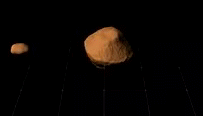(66391) 1999KW4
Track this Asteroid!
Everyone's images are automatically combined into a timelapse video, shown below.
Timelapse made from 45 images, last updated May 27, 2019, 5:13 p.m.
Information
What is it?
The asteroid with the number 66391 (also known as 1999 KW4) is what is known as a Near Earth Asteroid because its orbit around the Sun takes it close to Earth’s orbit. Unlike the vast majority of asteroids orbiting the sun in the Main Asteroid Belt between Mars and Jupiter, these objects spend much of their time closer to the Sun and can even cross Earth’s path making them potentially hazardous. Over 20,000 objects have been classified as Near Earth Asteroids so far, most of which are quite small, and therefore hard for astronomers to study unless they are very close to Earth. Keeping track of these objects and understanding their behavior and composition is not only important to keeping us safe on Earth, but also to understanding how the Solar System developed and changed with time.
Who found it ?
Near Earth Asteroid (66391) 1999 KW4 was first discovered in 1999 by the Lincoln Laboratory’s Near Earth Asteroid Research survey (LINEAR) using telescopes at the Experimental Test Site (ETS) in White Sands Missile Range. The White Sands Missile Range is located near Socorro, New Mexico, close to the Very Large Array (VLA), which was featured in the movie Contact, starring Jodie Foster. White Sands Missile Range was the site of the Trinity test of the first nuclear bomb and also served as a alternate landing field for the Space Shuttle. The early shuttle mission STS-3 landed there in 1982, ironically due to flooding of the runway on the desert playa at Edwards Air Force Base in California.
What do we know about it?
With over three thousand measurements spanning twenty years taken by many observers since discovery, we have been able to find out a few interesting facts about 1999 KW4. 1999 KW4 orbits the sun every 0.51 years or about 186 days. Its orbit has an eccentricity of 0.69 meaning it is quite elliptical (the eccentricity of a circle is 0). Also its orbit is tilted at a high angle of 39 degrees compared to Earth's orbit.

By Dr. Steven Ostro et al. - http://echo.jpl.nasa.gov/~ostro/kw4/, Public Domain, Link
1999 KW4 has been classified as an Aten asteroid (which means that it crosses the Earth’s orbit. 1999 KW4 also crosses the orbit of Mercury and Venus getting within 0.2 AU distance of the Sun (1 AU is the average Earth-Sun distance). On May 25th 2019 1999 KW4 will speed past Earth at 21 km/s passing by as close as 13.5 times the distance from Earth to the Moon (3.2 million miles). This is the 6th of a series of nine close approaches to the Earth each year, all around the end of May or start of June. This year’s close approach is the closest approach to Earth of the series.
Who is watching it?
Radar images from the closest approach in the last set of close approaches in 2001 confirmed that 1999 KW4 is actually a binary asteroid. Las Cumbres Observatory are part of global observing campaign via the International Asteroid Warning Network (IAWN) and coordinated by NASA’s Planetary Defense Coordination Office to further characterize this interesting binary asteroid system.
The main body (primary) of 1999 KW4 is about 1300 meters across, but is actually quite a complex shape. It is slightly squashed at the poles and with a mountain ridge around the equator, which runs all the way around the asteroid. This ridge gives the primary an appearance similar to a walnut or a spinning top. The secondary is about 500 meters across and the two asteroids orbit each other every 17.5 hours at a distance of about 1.6 miles. We have a good idea of what the asteroid is made up of from previous radar images. The asteroid is a rocky “rubble pile” but there must be considerable gaps between the “rubble” as the density is lower than that of typical Earth rocks.

By Dr. Steven Ostro et al. - http://www.nasa.gov/, Public Domain, Link
1999 KW4 is a radar target for both of the planetary radars at Goldstone and the Planetary Radar Science group working at the Arecibo Observatory. The Arecibo Observatory is home to the world's largest radio telescope which is located in Puerto Rico. Their goals are to take observations that will improve the model of 1999 KW4's shape, surface properties and measure the rotation period of the binary and of the primary and secondary. They do this by sending radio waves at the asteroid and measuring the waves that bounce off. With these measurements, the radar groups will also be able to refine its orbit and determine the size precisely.
Why is it interesting?
1999 KW4 is the focus of this year’s International Asteroid Warning Network (IAWN) Campaign to test Earth’s capability to characterize and prepare for an incoming, potentially hazardous asteroid. Even though we know 1999 KW4 poses no threat to Earth, because it comes so close, the idea is to use as many resources as possible to learn everything we can about it and really push our observing abilities to the limit. You and LCO can be a part of this global observing campaign via IAWN and coordinated by NASA’s Planetary Defense Coordination Office to characterize 1999 KW4. Join us and astronomers all over the world as we try to learn everything they can about both this interesting binary Near Earth Asteroid system and our own level of preparedness for a more dangerous encounter in the future.